Farmer’s Perception on Supply-Demand Matching of New Variety and Its Influence Factors
College of Economics and Management, Huazhong Agricultural University, Wuhan 430070, China
1 Introduction
At present, there is no professional research about supply-demand matching of crop seed at home and abroad, and most of researches about supply-demand matching status concentrate in the aspects of knowledge, talent and logistics, and the field referring to agriculture concentrates in the level of agricultural promotion technique. Under market economy conditions, thinking ways of promotion department and personnel lag behind the farmers’ demand levels on agricultural technology[1], making that agricultural technology required by the farmers and the used agricultural technology have difference[2]. This kind of "disconnection" phenomenon between technology supply body and farmer finally causes the dual contradiction between insufficient effective supply and demand of agricultural technology in China[3-7]. At present, there is obvious difference between the two sides of agricultural technology supply and demand in China, and unbalanced matching phenomenon between farmer demand and agricultural technology supply at the amount, structure and content appears. In current rural crop seed market, some farmers have strong demands on new varieties, and are willing to spend more money to get new varieties, while enterprises still sell old varieties to stabilize the market or because of without good science research ability. There is mismatch contradiction between new variety supply of enterprise and farmer’s demand on new variety. For the famers, the phenomenon of supply-demand mismatching causes that the demand on new varieties can not be met, or they do not know what course to take in the face of new varieties, which senselessly increases their economic and learning costs. For the enterprise, the phenomenon of supply-demand mismatching can cause customer’s displeasure because that new variety can not meet farmers’ demands well or increases farmers’ loads, thereby losing customers. From a long-term point of view, it also affects whole agricultural production and healthy development of crop seed market. On this basis of questionnaire investigation on 385 households in Hubei, Shandong and Anhui and key interviews on some farmers, the above problems are analyzed, which aims to provide the reference for seed company making scientific and rational supply strategy of new variety and easing supply-demand matching contradiction of new variety.
2 Theoretical basis and research hypothesis
Although there is no special research about supply-demand matching of crop seed, farmer’s perception and evaluation on supply-demand matching status of new variety is a cognition on if supply and demand of new variety are matching and equivalent on the market.Many scholars think that technology choice and decision-making behavior of farmer are affected by individual psychological characteristics of farmer, cognition of new variety and other factors[8]. Huang Yuxiangetal. think that the possibility of technological cognition is larger by stronger curiosity about new technology[9]. Ren Keshuangetal. think that farmers do not have the knowledge and professional science and technology of seed quality identification[10]. Li Nannanetal. think that farmers’ abilities of accepting new things are different[11]. Chen Xinjianetal. find that farmer’s risk attitude has significant impact on his input in new technology, and farmers’ input in new technology has risk circumvention psychology[12]. When farmer thinks that technology production or new variety using behavior has larger risk, it will affect his using behavior[13-15]. Ma Xiaoyongetal. also think that risk awareness and aversion degree affect the acceptance of new variety greatly[16-17]. It is clear that risk preference significantly affects farmer’s cognition on agricultural technology and using behavior[18-19]. In summary, farmer’s psychological characteristics contain risk preference, psychology seeking innovation, learning and cognition ability, which affects farmer’s cognition on seed technology and perception on supply-demand matching status of seed. In new variety using theory, farmer’s cognition on new seed variety affects his final using willingness and behavior[20-22], and farmer’s cognition on new variety is affected by farmer’s psychological characteristics. Farmer’s attitude has great impact on adoption of new variety[23-24]. When studying flower farmer using new variety, Zhang Yuanetal. find that farmer’s desire adopting new variety is strong when the cognition on advantage of new variety is sufficient. New variety is the best carrier of modern agricultural science and technology[25], and many scholars also concern that the utilization of new technology by the farmers involves the willingness to demand of new crop variety and its influencing factors. So to sum up, the research about the influencing factors of agricultural crop seed supply-demand matching is conducted from two aspects: one is farmer’s cognition on seed technology and farmer’s psychological characteristics, and the corresponding research hypothesis is proposed (Fig.1).
H1:farmer’s psychological characteristics affect farmer’s perception on supply-demand matching situation of new variety (H1a:risk preference affects farmer’s perception on supply-demand matching situation of new variety; H1b:psychology seeking the innovation affects farmer’s perception on supply-demand matching situation of new variety; H1c:learning and cognition ability affects farmer’s perception on supply-demand matching situation of new variety.
H2:farmer’s psychological characteristics affect cognition of seed technology (H2a:risk preference affects cognition of technological importance; H2b:risk preference affects cognition of technological difference; H2c:psychology seeking the innovation affects cognition of technical importance; H2d:psychology seeking the innovation affects cognition of technical difference; H2e:learning and cognition ability affects cognition of technological importance; H2f:learning and cognition ability affects cognition of technical difference).
H3:farmer’s cognition on seed technology affects the farmer’s perception on supply-demand matching situation of new variety (H3a:cognition on technical importance affects perception on supply-demand matching situation of new variety; H3b:cognition on technical difference affects perception on supply-demand matching situation of new variety).
H4:farmer’s cognition on seed technology has intermediary effect between psychological characteristics and perception on supply-demand matching situation (H4a:cognition of technical importance has intermediary effect between risk preference and perception on supply-demand matching situation of new variety; H4b:cognition of technical importance has intermediary effect between psychology seeking the innovation and perception on supply-demand matching situation of new variety; H4c:cognition of technical importance has intermediary effect between learning and cognition ability and perception on supply-demand matching situation of new variety; H4d:cognition of technical difference has intermediary effect between risk preference and perception on supply-demand matching situation of new variety; H4e:cognition of technical difference has intermediary effect between psychology seeking the innovation and perception on supply-demand matching situation of new variety; H4f:cognition of technical difference has intermediary effect between learning and cognition ability and perception on supply-demand matching situation of new variety).

Fig.1Theresearchmodelfor"farmer’sperceptiononsupply-demandmatchingsituationofnewvarietyanditsinfluencingfactors"
3 Research design and methods
3.1DefinitionsandmeasurementsofvariablesQuestionnaire is designed into four parts, and the first part is basic information of the investigator, including sex, age, cultural degree, cultivated land area, planting willingness, the situation of concurrent industry, years of planting experience and perception on supply-demand matching situation of new variety. The second part is farmer’s measurement on cognition of seed technology, including farmer’s cognition on technical importance of seed and cognition on technical difference of seed. The third part is measurement on farmer’s psychological characteristics, including farmer’s psychology seeking the innovation, risk preference, learning and cognition ability. The second and third parts use Li Kete five-grade measurement table in the design of measuring word choice, and 1-5 respectively represent "very disagree", "disagree", "general", "agree" and "very disagree". The fourth part is farmer’s evaluation on perception of supply-demand matching situation of new variety. This part is divided into four options according to the matching degree between farmer’s demand intensity on new variety and supplying velocity of new variety on the market, and they are respectively high-level supply-demand balance, oversupply, supply falling short of demand and low-level supply-demand balance, and each option is accompanied with corresponding value. The definitions and measurements of research variables are shown as Table 1.
Table1Thedefinitionsandmeasurementsofresearchvariables
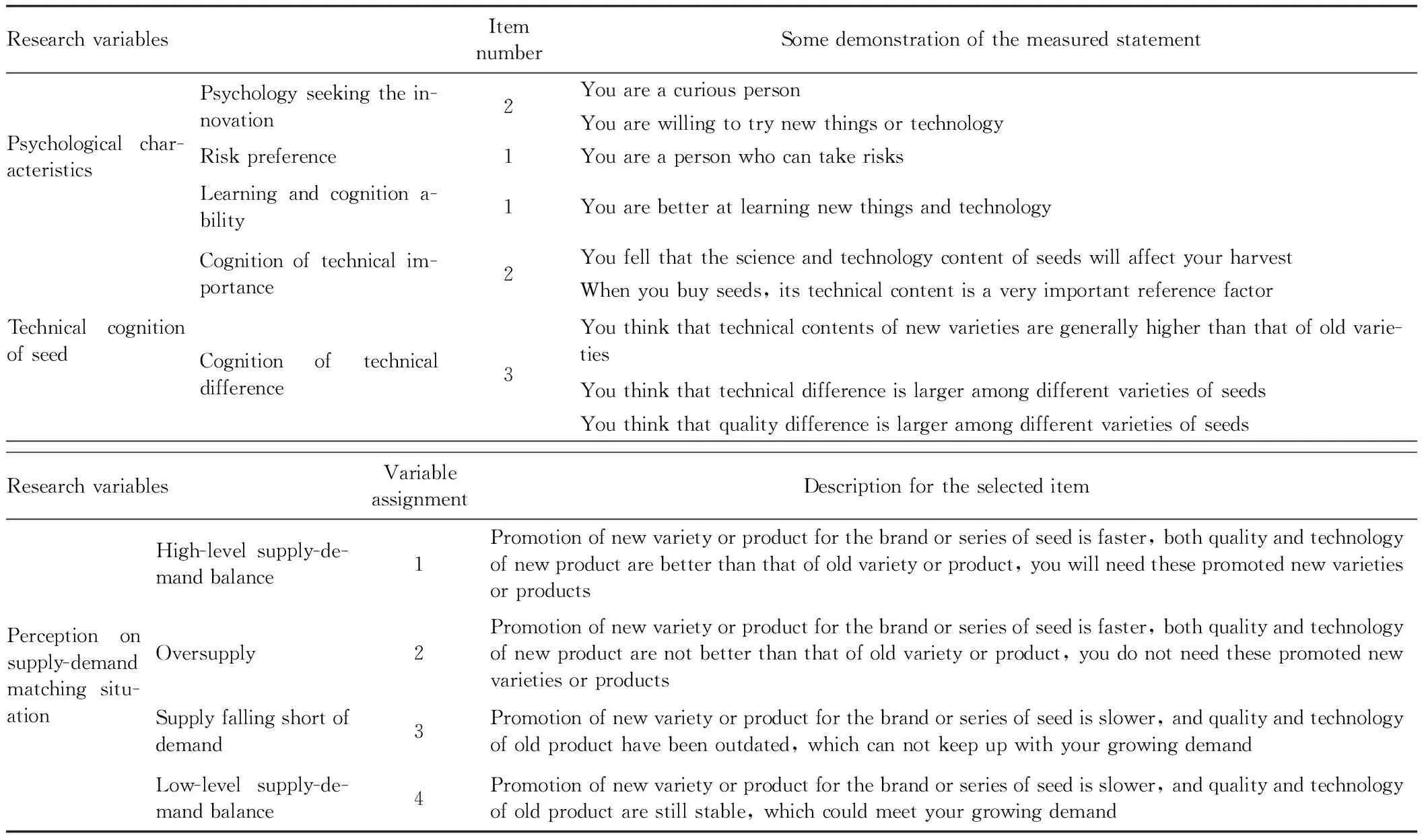
ResearchvariablesItemnumberSomedemonstrationofthemeasuredstatementPsychologicalchar-acteristicsPsychologyseekingthein-novation2YouareacuriouspersonYouarewillingtotrynewthingsortechnologyRiskpreference1YouareapersonwhocantakerisksLearningandcognitiona-bility1YouarebetteratlearningnewthingsandtechnologyTechnicalcognitionofseedCognitionoftechnicalim-portance2Cognitionoftechnicaldifference3YoufellthatthescienceandtechnologycontentofseedswillaffectyourharvestWhenyoubuyseeds,itstechnicalcontentisaveryimportantreferencefactorYouthinkthattechnicalcontentsofnewvarietiesaregenerallyhigherthanthatofoldvarie-tiesYouthinkthattechnicaldifferenceislargeramongdifferentvarietiesofseedsYouthinkthatqualitydifferenceislargeramongdifferentvarietiesofseedsResearchvariablesVariableassignmentDescriptionfortheselecteditemPerceptiononsupply-demandmatchingsitu-ationHigh-levelsupply-de-mandbalance1Promotionofnewvarietyorproductforthebrandorseriesofseedisfaster,bothqualityandtechnologyofnewproductarebetterthanthatofoldvarietyorproduct,youwillneedthesepromotednewvarietiesorproductsOversupply2Promotionofnewvarietyorproductforthebrandorseriesofseedisfaster,bothqualityandtechnologyofnewproductarenotbetterthanthatofoldvarietyorproduct,youdonotneedthesepromotednewvarietiesorproductsSupplyfallingshortofdemand3Promotionofnewvarietyorproductforthebrandorseriesofseedisslower,andqualityandtechnologyofoldproducthavebeenoutdated,whichcannotkeepupwithyourgrowingdemandLow-levelsupply-de-mandbalance4Promotionofnewvarietyorproductforthebrandorseriesofseedisslower,andqualityandtechnologyofoldproductarestillstable,whichcouldmeetyourgrowingdemand
3.2Datasourceandbasicsituationoftheinvestigator
From December 2014 to July 2015, field research on farmers was conducted in Xiantao, Tianmen, Qianjiang, Jingzhou of Hubei, Jining, Heze of Shandong and Fuyang of Anhui. There were 355 copies of questionnaires in total, in which 336 copies of effective questionnaires were recovered. Because that farmer’s cognitive ability is limited, and their culture level is generally low, direct interview survey on farmer is conducted by the way directly entering into home, which combines interview with self-administered questionnaire. Before formal questionnaire on farmer, research personnel must firstly query that "are you the decision maker of buying seed at home" or "does your opinion have important impact on the decision of buying seed at home", to judge if the farmer meets the condition of the investigator. If the answer of the respondent is yes, and he shows good expression ability and clear thinking in communication process, then we enter into the below questionnaire link, otherwise give up(Table 2).
4 Research results and analysis
4.1Effectsofpsychologicalcharacteristicsonperceptionofsupply-demandmatchingsituationCombining the above models and hypotheses and using SPSS17.0 software, farmer’s psychological characteristic is taken as independent variable, and farmer’s perception on supply-demand matching condition is taken as dependent variable for regression analysis. Dependent variables are four options of perception evaluation, and there is no order of advantage and disadvantage among the four options, and they are disordered class variables. Therefore, we use disordered multinomial logistic regression method. In Table 3, -2 times of LLR for zero model is 171.545, while it is 171.545 for current model. Likelihood ratio chi square value is 113.258, and probabilityPvalue is 0.000. Under 0.001 of significance level, it should reject zero hypothesis of regression equation significance test. In the model, all independent variables have significant linear relationship with broad-sense logitP, showing that model selection is correct. Nagelkerke R square statistic is used to inspect fitting goodness of regression equation, which reflects interpretation degree of the equation on dependent variable becoming bad. Nagelkerke R square of current model is 0.321, showing that the equitation could explain 32.1% of variation from dependent variable. Likelihood ratio test gives variation situation of likelihood ratio chi square value when the model introduces each independent variable. Chi square test probability P values of risk preference, psychology seeking innovation, learning and cognition ability are 48.384, 21.751 and 28.370, and they are respectively under 0.01, 0.05 and 0.01 of significance levels (Table 4). It could be judged that three common factors in farmer’s psychological characteristics all have significant impacts on dependent variable, that is, hypothesis H1 is verified.
Table2Descriptivestatisticalanalysisresultforbasicsituationoftherespondent
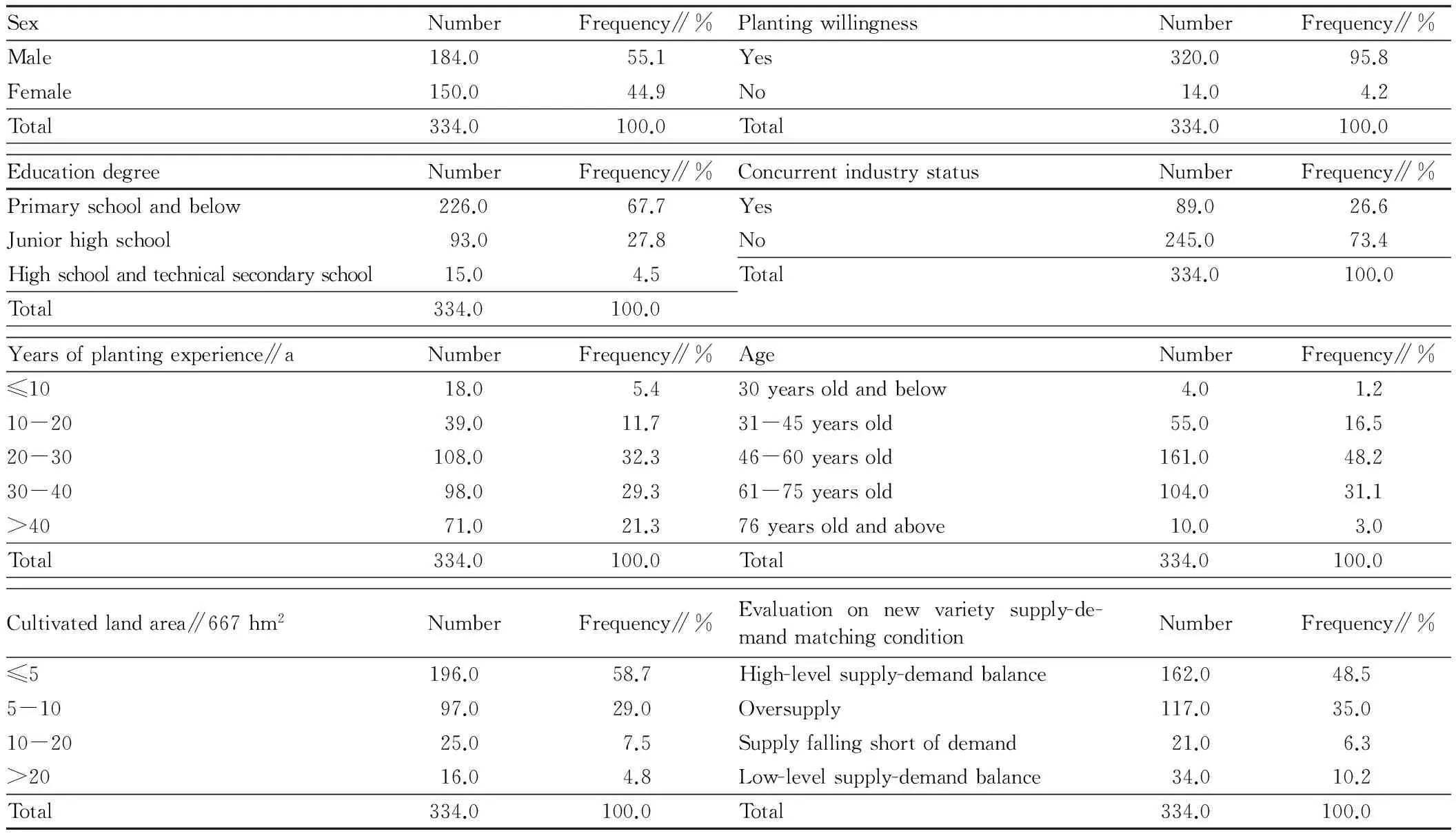
SexNumberFrequency∥%PlantingwillingnessNumberFrequency∥%Male184.055.1Yes320.095.8Female150.044.9No14.04.2Total334.0100.0Total334.0100.0EducationdegreeNumberFrequency∥%ConcurrentindustrystatusNumberFrequency∥%Primaryschoolandbelow226.067.7Yes89.026.6Juniorhighschool93.027.8No245.073.4Highschoolandtechnicalsecondaryschool15.04.5Total334.0100.0Total334.0100.0Yearsofplantingexperience∥aNumberFrequency∥%AgeNumberFrequency∥%≤1018.05.430yearsoldandbelow4.01.210-2039.011.731-45yearsold55.016.520-30108.032.346-60yearsold161.048.230-4098.029.361-75yearsold104.031.1>4071.021.376yearsoldandabove10.03.0Total334.0100.0Total334.0100.0Cultivatedlandarea∥667hm2NumberFrequency∥%Evaluationonnewvarietysupply-de-mandmatchingconditionNumberFrequency∥%≤5196.058.7High-levelsupply-demandbalance162.048.55-1097.029.0Oversupply117.035.010-2025.07.5Supplyfallingshortofdemand21.06.3>2016.04.8Low-levelsupply-demandbalance34.010.2Total334.0100.0Total334.0100.0
Table3Simulatedfittinginformationforeffectsofpsychologicalcharacteristicsonperceptionofsupply-demandmatchingsituation

Model-2timesofLLRLikelihoodratiotestChisquaredfSignificancelevelOnlytheintercept284.803Final171.545113.258450.000***
Note:***shows significance at the level of 0.001.
Table4Likelihoodratiotestforeffectsofpsychologicalcharacteristicsonperceptionofsupply-demandmatchingsituation

Effect-2timesoflogfittingvalueforthesimplifiedmodelLikelihoodratiotestChisquaredfSignificancelevelIntercept1.7150.0000.000Riskpreference219.92948.38421.0000.001**Psychologyseekinginnovation193.29721.75112.0000.040*Learningandcognitionability199.91528.37012.0000.005**
Note:**shows significance at the level of 0.01;*shows significance at the level of 0.05.
4.2EffectsofpsychologicalcharacteristicsonseedtechnologycognitionTo exclude multiple co-linearity among measuring words of variables, stepwise regression method is used to analyze causal relationship between farmer’s psychological characteristics and cognition on new variety, and result is shown as Table 5. In regression model of technology importance cognition, only learning and cognition ability enters into regression equation, with 0.329 of standard coefficient. Both regression t value and F statistic are significant at the level of 0.001, illustrating regressive model is significantly effective, and also regression analysis result. Therefore, farmer’s learning and cognition ability affects technology importance cognition. Research hypothesis H2e is verified, while H2a and H2c are not verified. In regression model of technology difference cognition, both risk preference(-0.19 of standard coefficient)and learning and cognition ability (0.291 of standard coefficient) enter into the regression equation. Both regression t value and F statistic are significant at the level of 0.01, illustrating that regression model is significantly effective, and also regression analysis result. Therefore, farmer’s risk preference and learning and cognition ability affect technology difference cognition. Research hypotheses H2b and H2f are verified, while H2d is not verified, and H2 only has a part of hypothesis passing the test.
Table5Regressionanalysisofpsychologicalcharacteristicsonseedtechnologycognition

DependentvariablesModelStandardcoefficientTAdjustedRsquareFvalueTechnologyimportancecogni-tionTechnologydifferencecogni-tion112(Constant)23.755Learningandcognitionability0.3296.351***(Constant)17.504Learningandcognitionability0.1442.657**(Constant)17.671Learningandcognitionability0.2913.447**Riskpreference-0.190-2.258*0.10640.336***0.0187.062**0.0306.125**
Note:***shows significance at the level of 0.001;**shows significance at the level of 0.01;*shows significance at the level of 0.05.
4.3Effectofseedtechnologycognitiononperceptionofsupply-demandmatchingsituationIn Table 6, -2 times of IIR for zero model is 463.820, while current model is 335.085. Likelihood ratio chi square value is 128.735, and probability P value is 0.014. Under significance level of 0.05, it should reject zero hypothesis of regression equation significance test. In the model, all independent variables show significant linear relationship with broad-sense logitP, illustrating that model selection is correct. Nagelkerke R square statistic is used to inspect fitting goodness of regression equation, which reflects interpretation degree of the equation on dependent variable becoming bad. Nagelkerke R square of the current model is 0.358, showing that the equation could explain 35.8% of change from dependent variable. Likelihood ratio test gives change situation of likelihood ratio chi square value when each independent variable is introduced into the model. Chi square test probability P values of seed technology cognition and technology difference cognition are 4.257 and 3.848, which are both under 0.05 of significance level (Table 7). It could be judged that two common factors in farmer’s cognition on seed technology both have significant impact on dependent variable, that is, hypothesis H2 is verified. Model 1 is regression analysis of three common factors from farmer’s psychological characteristics on perception of supply-demand matching condition. F statistical value and regression coefficient c of the three common factors are all significant, which could enter into the next-step regression test. Model 2 is regression analysis of three common factors from farmer’s psychological characteristics on perception of technology importance. F statistical value and regression coefficient a of independent variable are all significant, which could continue to enter into the next-step regression test. Model 3 is regression analysis of farmer’s psychological features and technology importance cognition on perception of supply-demand matching situation, and test regression coefficients are b and c’. Result shows that regression coefficient b is not significant, and there is no mesomeric effect, that is, cognition on technology importance does not have mesomeric effect between farmer’s psychological characteristics and perception on supply-demand matching condition. Model 4 is regression analysis of three common factors from farmer’s psychological characteristics on perception of supply-demand matching condition, and F statistical value and regression coefficient c of the three common factors are all significant, which could enter into the next-step regression test. Model 5 is regression analysis of three common factors from farmer’s psychological characteristics on technology difference cognition. Only F statistical value and regression coefficient a of psychology seeking the innovation and learning and cognition ability are significant at the levels of 0.05 and 0.01, which could enter into the next-step regression test. Model 6 is regression analysis of psychology seeking the innovation, learning and cognition ability, technology difference cognition on perception of supply-demand matching condition, and test regression coefficients are b and c’. Result shows that in regression analysis of psychology seeking the innovation, learning and cognition ability on cognition of technology difference and perception of supply-demand matching situation, regression coefficient b is significant, and also the coefficient c’, showing that there exists partial mesomeric effect. Seen from the above result, in the hypothesis H4, only H4e and H5f pass the verification, and other hypotheses do not pass the test.
Table6Simulatedfittinginformationforeffectofseedtechnologycognitiononperceptionofsupply-demandmatchingsituation

Model-2timesofLLRLikelihoodratiotestChisquaredfSignificancelevelOnlyintercept463.820Final335.085128.73596.0000.014*
Note:*shows significance at the level of 0.05.
Table7Likelihoodratiotestforeffectofseedtechnologycognitiononperceptionofsupply-demandmatchingsituation

Effect-2timesoflogfittingvalueofthesimplifiedmodelLikelihoodratiotestChisquaredfSignificancelevelIntercept3.3510.0000.000Seedtechnologycognition4.25790.61363.0000.013*Technologydifferenceperception3.84849.75033.0000.031*
Note:*shows significance at the level of 0.05.
4.4Testofseedtechnologycognitiononmesomericeffectbetweenfarmer’spsychologicalcharacteristicsandperceptionofsupply-demandmatchingconditionTable 8 and Table 9 are tests of seed technology cognition on mesomeric effect between farmer’s psychological characteristics and perception of supply-demand matching condition.
Table8Testoftechnologyimportancecognitiononmesomericeffectbetweenfarmer’spsychologicalcharacteristicsandperceptionofsupply-demandmatchingcondition
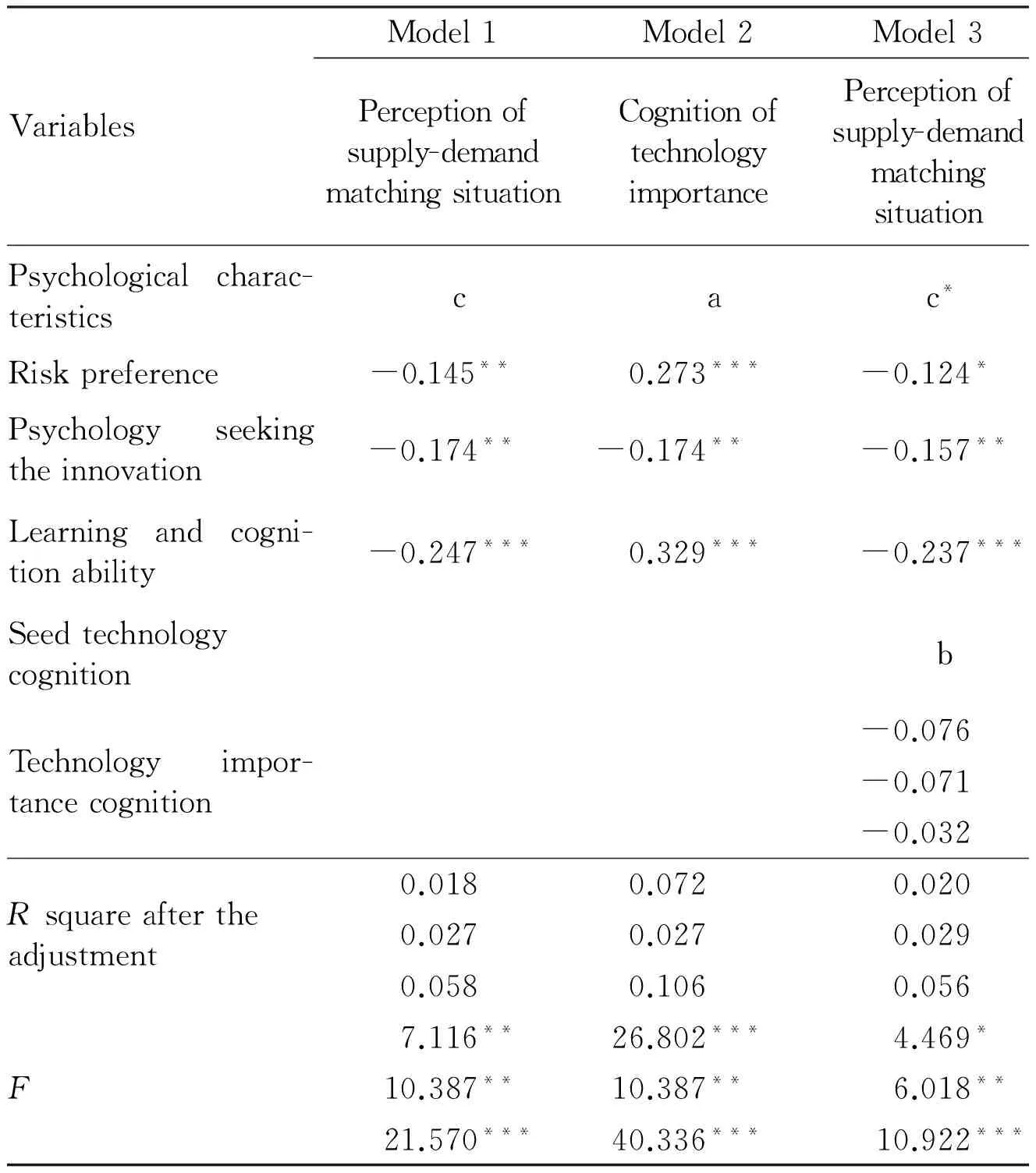
VariablesModel1Model2Model3Perceptionofsupply-demandmatchingsituationCognitionoftechnologyimportancePerceptionofsupply-demandmatchingsituationPsychologicalcharac-teristicsRiskpreferencePsychologyseekingtheinnovationLearningandcogni-tionabilitySeedtechnologycognitionTechnologyimpor-tancecognitionRsquareaftertheadjustmentF c a c*-0.145**0.273***-0.124*-0.174**-0.174**-0.157**-0.247***0.329***-0.237*** b-0.076-0.071-0.0320.0180.0720.0200.0270.0270.0290.0580.1060.0567.116**26.802***4.469*10.387**10.387**6.018**21.570***40.336***10.922***
Note:***shows significance at the level of 0.001;**shows significance at the level of 0.01;*shows significance at the level of 0.05.
5 Research conclusions and suggestions
Using disordered multinomial logistic regression and multiple linear regression method, 385 copies of questionnaires on farmers are analyzed to explore the relationship between farmer’s psycho-logical characteristics, farmer’s cognition on seed technology and perception on supply-demand matching of new variety. Research results show that psychology seeking the innovation, risk preference, learning and cognition ability in farmer’s psychological characteristics all significantly affect farmer’s perception on sup-plydemand matching situation of new variety, and farmer with stronger learning and cognition ability, preferring risk and seeking innovation tends to choose high-level supply-demand balance;farmer’s learning and cognition ability affects technology importance cognition. The farmer with stronger learning and cognition ability could perceive technology’s importance;farmer’s risk preference, learning and cognition ability affect technology difference cognition. The farmer with stronger learning ability and preferring risk has stronger cognition on technology difference;farmer’s cognition on seed technology significantly affects perception on supply-demand matching situation of new variety, that is, the farmer who could perceive seed technology importance and difference tends to select high-level supply-demand balance of new variety;psychology seeking the innovation, learning and cognition ability have partial mesomeric effect between technology difference cognition and perception on supply-demand matching condition, and the effects of psychology seeking innovation and learning and cognition ability on perception of supply-demand matching situation are realized by technology difference cognition. Although we use typical sampling method in the research, there are some limitations in the region, and it also needs further enlarging the investigated region and collecting more representative sample data.
Table9Testoftechnologydifferencecognitiononmesomericeffectbetweenpsychologicalcharacteristicsandperceptionofsupply-demandmatchingsituation
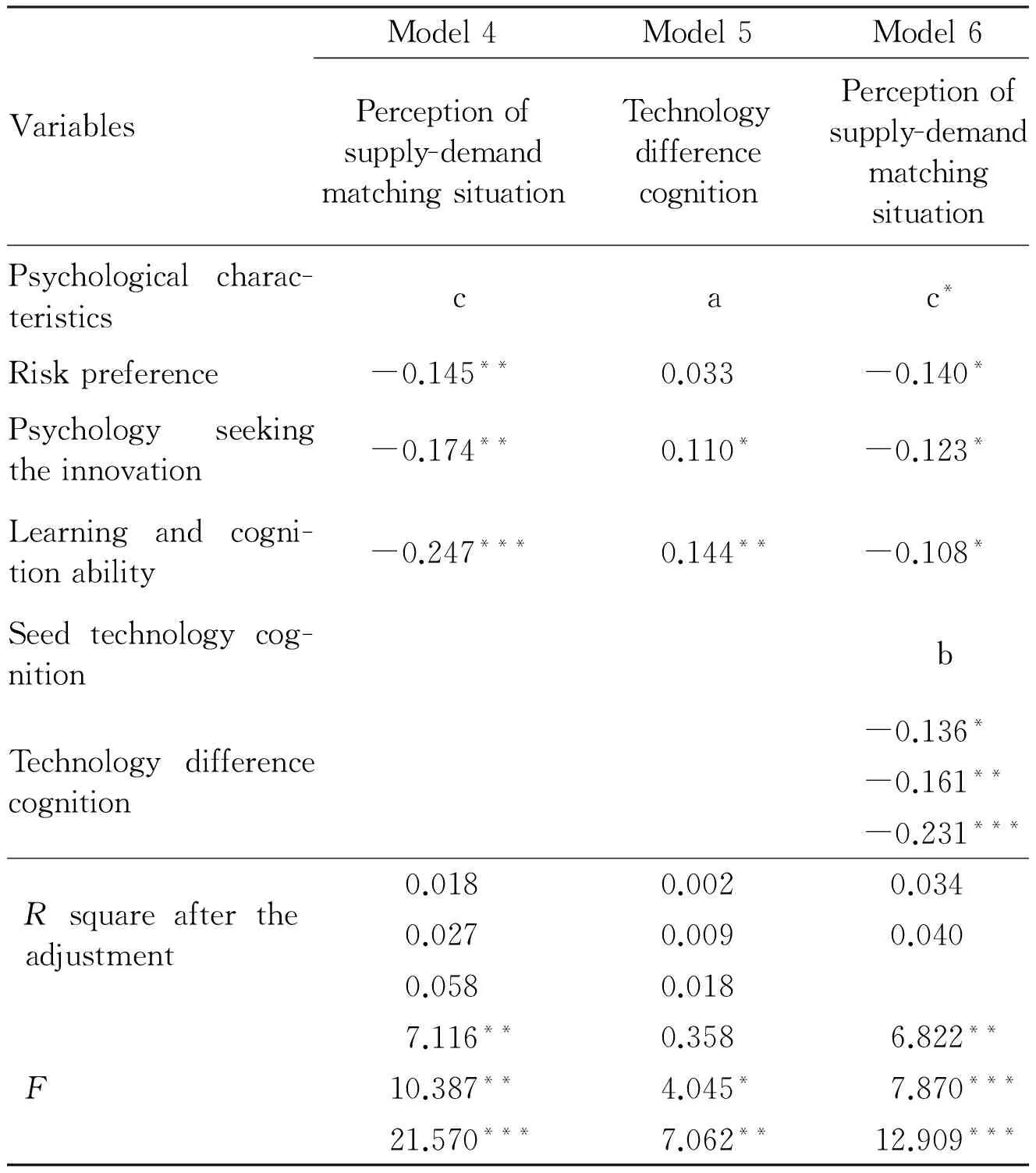
VariablesModel4Model5Model6Perceptionofsupply-demandmatchingsituationTechnologydifferencecognitionPerceptionofsupply-demandmatchingsituationPsychologicalcharac-teristics c a c*Riskpreference-0.145**0.033-0.140*Psychologyseekingtheinnovation-0.174**0.110*-0.123*Learningandcogni-tionability-0.247***0.144**-0.108*Seedtechnologycog-nition bTechnologydifferencecognition-0.136*-0.161**-0.231***RsquareaftertheadjustmentF0.0180.0020.0340.0270.0090.0400.0580.0187.116**0.3586.822**10.387**4.045*7.870***21.570***7.062**12.909***
Note:***shows significance at the level of 0.001;**shows significance at the level of 0.01;*shows significance at the level of 0.05.
There are three suggestions in total. (i)Firstly, on the basis of old variety, seed company should guarantee that the performance and yield of new variety are improved greatly. Secondly, promotion rhythm of new variety by seed company should refer to farmer’s need, and it should scientifically and rationally carry out technology innovation and production of new variety according to evaluation on supply-demand matching situation from different farmers. (ii)Firstly, government departments should do a good job of propaganda work at seed technology knowledge and agricultural science innovation, promote the increase of farmer technology knowledge and cognition on technology difference via multiple means, such as newspaper, publicity list, publicity column, broadcast, TV and village cadre personnel training, and improve farmer’s cognition and acceptance on seed technology. Government department also should comprehensively supervise the market, and prevent product mixing and disorder phenomenon of seed market, thereby indirectly improving farmer’s ability resisting risk. Finally, it needs government encouraging land transfer by policy making, or regulating land contract and enlarging land planting scale via financial subsidies or tax. (iii)As far as farmers themselves are concerned, they need continuously improving self cultural knowledge accomplishment, increasing learning and grasping ability of new thing or technology, accurately understanding seed’s technology, distinguishing the difference among seed varieties, and acknowledging and accepting new seed variety by an open and tolerant altitude.
[1] JIAN XY. New approach of agricultural extension with farmer’s needs orientation [J]. Science & Technology Progress and Policy, 2007(7): 44-46.(in Chinese).
[2] LI YH, FENG G. On the current situation of agricultural technology demand and adoption in China-Based on the analysis of farmers investigation [J]. Agricultural Economy, 2010(11): 83-85.(in Chinese).
[3] LING YY, GUO YH. The priority order of agricultural scientific research: Discussion on the angle of technology adoption [J]. Chinese Rural Economy, 1997(8): 69-73.(in Chinese).
[4] HU HZ, ZHANG JS. The supply and demand mechanism perfecting the transformation of scientific and technological achievements in agriculture [J]. Journal of Agrotechnical Economics, 1997(2): 21-22,36. (in Chinese).
[5] HUANG JK, HU RF, SONG J,etal. On agricultural technology from production to adoption:Comparison on the behaviors of government, scientific research personnel, technology-extension workers and farmers [J]. Impact of Science on Society, 1999(1): 55-60.(in Chinese).
[6] DU SG. Agricultural technology innovation and promotion strategies based on coupling of supply and demand of technology [J].Journal of Anhui Agricultural Sciences, 2014(27):9573-9576. (in Chinese).
[7] MAN MJ, LI TS. Research summary on agricultural technology adoption [J]. Research on Development, 2010(1): 80-85.(in Chinese).
[8] SHI HJ, HUANG HL. Psychological analysis on agricultural technology adoption behavior of the farmers [J]. Guizhou Agricultural Sciences, 2013(4): 209-213.(in Chinese).
[9] HUANG YX, HAN WT, ZHOU L,etal. Farmer cognition on water-saving irrigation technology and its influencing factors analysis [J]. Transactions of the Chinese Society of Agricultural Engineering, 2012(18): 113-120. (in Chinese).
[10] REN KS, LI YJ. An empirical research on farmers adoption behavior and effect factors in the process of new breed’s diffusion [J]. Wuhan: Huazhong Agricultural University, 2008. (in Chinese).
[11] LI NN, LI TS. Study on the spatial variation of agricultural technique application behavior and its influencing factors [D]. Xi’an: Northwest University, 2014. (in Chinese).
[12] CHEN XJ, YANG ZY. Farmer’s endowments, risk preference and farmer’s technology input behavior-Empirical analysis of fruit farmers in Guangdong Province [J]. Science and Technology Management Research, 2015(17): 131-135. (in Chinese).
[13] GUO X, DONG WC. Study on agricultural technology extension system based on choices of farmers production technology [D].Nanjing: Nanjing Agricultural University, 2008.(in Chinese).
[14] ZHU GM, HUANG W. Empirical study on peanut producers’ technology adoption: A case of Chuzhou City [D]. Nanjing: Nanjing Agricultural University, 2011. (in Chinese).
[15] LUO L, LIU H, WEI YS. Analysis on farmer behaviors of updating rice varieties and related factors-Based on a survey in Hunan Province [J].Chinese Agricultural Science Bulletin, 2011(11): 187-192. (in Chinese).
[16] MA XY, BAI YX. On the adoption behavior of new varieties for farmers based on production risk and capital constraint [J]. Fujian Tribune (The Humanities & Social Sciences Bimonthly), 2013(3): 14-20.(in Chinese).
[17] YUAN JW, YAN L. Discussion on factors of influencing farming household’s acceptance for hybrid maize [J]. Journal of Anhui Agricultural Sciences, 2009(14): 6651-6652,6654. (in Chinese).
[18] SHI YM. Studies on the factors affecting the adoption of new technology in fine quality rice by the peasant households [D]. Beijing: China Agricultural University, 2004. (in Chinese).
[19] SHI HJ. An empirical study on farmer characteristics and resource endowment versus the adoption of Taiwan agricultural technologies [J].Acta Agriculturae Zhejiangensis, 2014(2): 522-529. (in Chinese).
[20] TAO W, XU X. Determinants of farmers’ adoption behavior in new varieties of black shrimp-Based on the survey in the black shrimp production area in Jiangsu Province [D].Nanjing: Nanjing Agricultural University, 2012. (in Chinese).
[21] ZHANG H. Effects of trust in government, cognition on farmers’ willingness to plant transgenic rice [J].Journal of Anhui Agricultural Sciences, 2015(24): 300-301. (in Chinese).
[22] LU Q, SUN J. Farmers’ perception and their planting willingness of genetically modified crops [J]. Journal of China Agricultural University, 2014(3): 34-42.(in Chinese).
[23] HE ZW, LIU F, DUAN YM. Analysis on the influencing factors of farmers adopting new rice varieties in Dali Prefecture [J]. China Seed Industry, 2014(10): 41-44. (in Chinese).
[24] JIN HY, LIU XL. Bean growers variety adoption behavior factors analysis and suggestions [J].Contemporary Eco-Agri Culture, 2012(1): 15-17. (in Chinese).
[25] ZHANG Y, ZHI L. Analysis of influencing factors of farmer planting desire for new varieties of flowers [J].Forest Inventory and Planning, 2012(4): 128-131. (in Chinese).
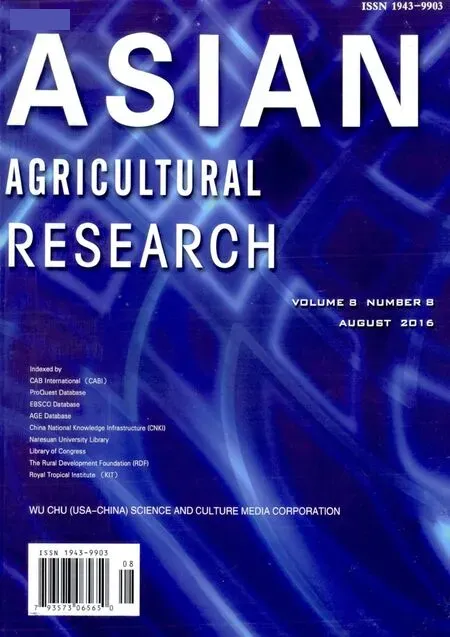 Asian Agricultural Research2016年8期
Asian Agricultural Research2016年8期
- Asian Agricultural Research的其它文章
- Empirical Analysis on Financial Development, Urbanization, and Urban and Rural Resident Income in Jiangsu Province
- Vegetation Coverage Changes in the West Qinling Region from 2000 to 2010: A Case Study of Longnan City
- A Study of Estimation Model for the Chlorophyll Content of Wheat Leaf Based on Hyperspectral Imaging
- A Study of Virtual Museum Simulation Platform Based on 2.5D Architectural Modeling Technology
- The Value Insistence of the Cultural Production in the Big Data Era
- Sino-Australian Agricultural Product Trade Development in the Context of the Belt and Road Initiative
